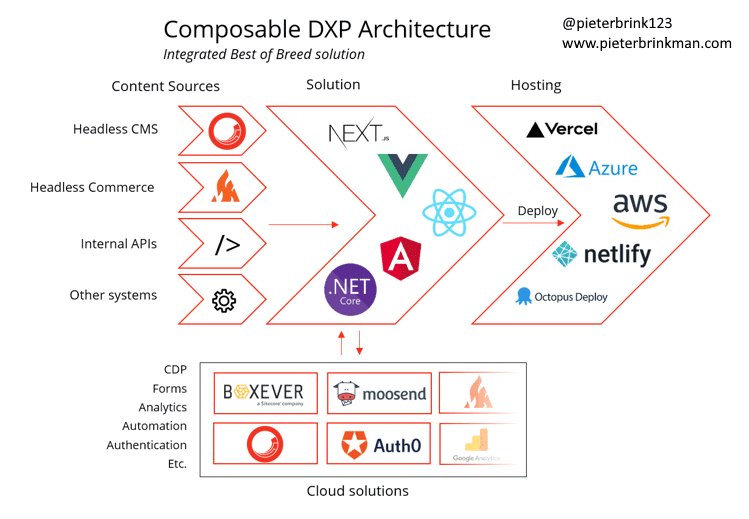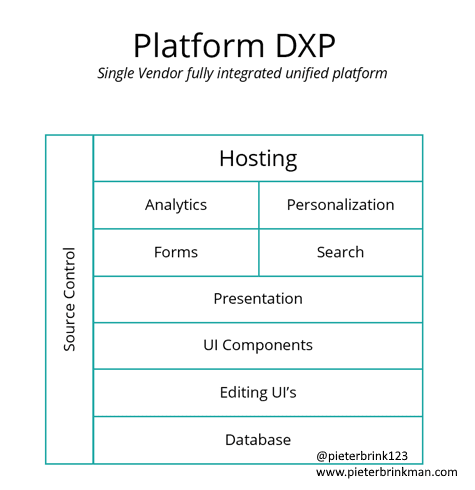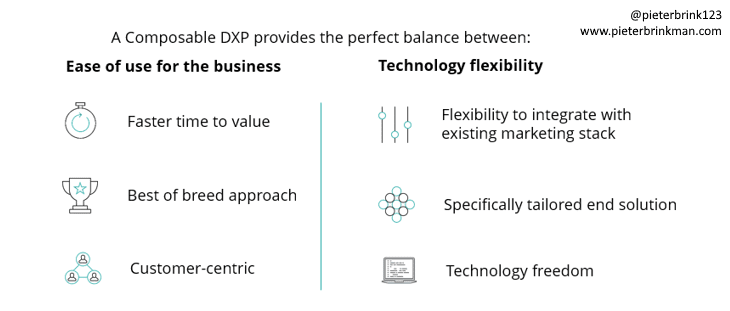If you follow the Digital Experience Platform (DXP) and web industry you seen that the industry is slowly moving away from Platform DXP’s to something called a Composable DXP.
In this article I want to address a few questions that I get asked a lot, including:
- What is a Composable DXP?
- What is the difference between a Composable DXP and a platform DXP?
- What are the key benefits of a Composable DXP.
Here we go!
What is Digital Experience Platform (DXP)?
Industry research and advisory firm Gartner defines DXP as:
“A digital experience platform (DXP) is an integrated set of core technologies that support the composition, management, delivery and optimization of contextualized digital experiences.”
A DXP consist out of three main pillars:
- Content is the main foundation of DXP.
It’s the starting point and the fuel of everything. You need content to drive Digital Experiences. The content pillar is all about content strategy, creation, collaboration and making the content available for consumption. - The Experience pillar is where we build digital experiences.
This includes tools for Analytics, Marketing Automation, Personalization and optimization. The content is powering the experiences. - The final pillar is Commerce.
With the commerce pillar we add the possibility to add conversion to experiences.
A good DXP solution combines Content, Experience and Commerce to maximize impact.
That brings us to the next questions; What is a Composable DXP and what is a Platform DXP and what are the differences?
What is a Composable DXP?
It is all in the name, Composable DXP. With a Composable DXP you COMPOSE a DXP that addresses current business requirements, challenges and opportunities by combining content sources with best of breed marketing stack, while not being restricted by technology or a single Vendor.
With a Composable DXP every feature or requirement can be individual standalone products. Allowing the customer to tailor the DXP solution around existing processes, infrastructure, and marketing stack.
The API’s of the cloud solutions, content sources and the integrations are expose the building blocks of the unique tailored DXP solution.
Breaking down the Composable DXP
A composable DXP exist out of multiple parts; Content Sources, Cloud Solutions, the Solution and hosting.

Content Sources
The composable the DXP has multiple content sources this could be your headless CMS, your headless commerce solution, or any internal systems that contain content and has an API to expose and/or interact with the content.
An application programming interface (API) is an interface that provides programmatic access to service functionality and data within an application or a database. It can be used as a building block for the development
Gartner
These content sources are the backbone of the content pillar of your digital experience.
Cloud solutions
The cloud solutions are best of breed API first SaaS solutions. These solutions can be from multiple vendors. Cloud solutions used in a Composable DXP can contain existing Marketing Stack and new solutions. You will combine multiple cloud solutions to cover the requirements the customer needs to drive success. For example, solutions for personalization, analytics, automation testing, forms, authentication, etc.
Some of these different DXP components might be provided by the same vendor, but typically in this approach the customer is choosing products from a variety of different vendors.
Solution
Then we have the solution. This is where you combine the content sources with best of breed cloud solutions. Composing the multiple sources and cloud solutions to achieve a Composable DXP with the feature set needed to drive success.
In this API first architecture you can build the Composable DXP in the content mesh with the programming language or framework you prefer. It is all about technology freedom.
Hosting
You can deploy your solution to your favorite hosting vendor and integrate with current deployment processes. Again, it is all about freedom of choice and removing technology restrictions.
What is a Platform DXP?
With a Platform DXP all of the different functions & features are bolted on topof each other in a single architecture, tightly coupled together.

Of course, there may be microservices under the hood powering the different elements, but they are not separate stand-alone products that can work on its own.
With this approach, you are buying the full stack of digital marketing solutions and all capabilities from a single vendor.
This is how Sitecore, with Sitecore XP and other Platform vendors works today.
It is the simplicity and complete feature set that attracts a lot of customers towards a stack like this, but the complexity of hosting and lack flexibility what is holding others back.
With Sitecore XP we chose to build the features in the platform natively, others industry vendors choose to acquire and stitch products together.
Benefits of a composable DXP
A composable DXP provides the perfect balance between ease of use for the business and technology flexibility.

It provides faster time to value. The API first implementation leads to faster implementations and deployments. The solution is based on industry standards, reducing the need for specific Vendor expertise. Making it easier to find talent for your development teams.
You only implement best of breed solution product covering the features that are needed to solve the business problems of today.
It’s fully customer centric. Instead of fitting your requirements to platform features you’re selecting the solutions that you need.
Not having a full platform DXP provides agility to quickly adjust to changing requirements, trends and world changing events.
While building out your Composable DXP you do not need to start from scratch. You don’t need to replace marketing stack that drives business value. The only requirement is that the marketing stack has an API that can be used to integrate with. This way you can slowly migrate to a Composable DXP and benefit from your efforts along the way.
In a composable DXP every solution is unique. A fully tailored solution using the unique combinations of content source, cloud applications, technologies, programming languages and hosting options.
Building out your composable DXP with your favourite Technologies and programming languages of your choice, without restrictions from vendors.
It is all about complete technology freedom and vendor freedom.

2 Replies to “Introduction to the Composable DXP”